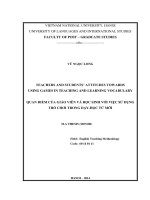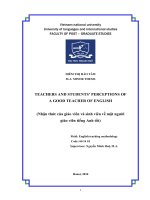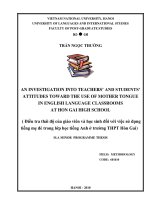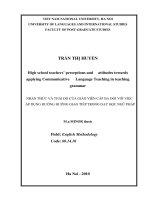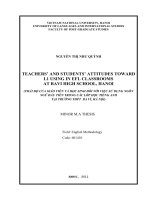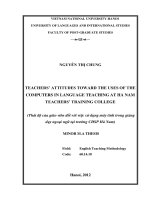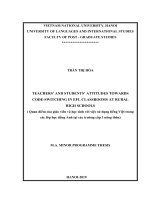Teachers' and students' attitudes toward L1 using in EFL classrooms = Thái độ của giáo viên và học sinh đối với việc sử dụng ngôn ngữ đầu tiên trong các lớp học
Bạn đang xem bản rút gọn của tài liệu. Xem và tải ngay bản đầy đủ của tài liệu tại đây (962.36 KB, 49 trang )
VIETNAM NATIONAL UNIVERSITY, HANOI
UNIVERSITY OF LANGUAGES AND INTERNATIONAL STUDIES
FACULTY OF POST-GRADUATE STUDIES
NGUYỄN THỊ NHƯ QUỲNH
TEACHERS’ AND STUDENTS’ ATTITUDES TOWARD
L1 USING IN EFL CLASSROOMS
AT BAVI HIGH SCHOOL, HANOI
(THÁI ĐỘ CỦA GIÁO VIÊN VÀ HỌC SINH ĐỐI VỚI VIỆC SỬ DỤNG NGÔN
NGỮ ĐẦU TIÊN TRONG CÁC LỚP HỌC TIẾNG ANH
TẠI TRƯỜNG THPT BA VÌ, HÀ NỘI)
MINOR M.A THESIS
Field: English Methodology
Code: 601410
HANOI, 2011
VIETNAM NATIONAL UNIVERSITY, HANOI
UNIVERSITY OF LANGUAGES AND INTERNATIONAL STUDIES
FACULTY OF POST-GRADUATE STUDIES
NGUYỄN THỊ NHƯ QUỲNH
TEACHERS’ AND STUDENTS’ ATTITUDES TOWARD
L1 USING IN EFL CLASSROOMS
AT BAVI HIGH SCHOOL, HANOI
(THÁI ĐỘ CỦA GIÁO VIÊN VÀ HỌC SINH ĐỐI VỚI VIỆC SỬ DỤNG NGÔN
NGỮ ĐẦU TIÊN TRONG CÁC LỚP HỌC TIẾNG ANH
TẠI TRƯỜNG THPT BA VÌ, HÀ NỘI)
MINOR M.A THESIS
Field: English Methodology
Code: 601410
Supervisor: MA.Lê Thế Nghiệp
HANOI, 2011
iv
TABLE OF CONTENTS
Page
ACKNOWLEDGMENTS
ii
ABSTRACT
iii
TABLE OF CONTENTS
iv
LIST OF TABLES
v
LIST OF FINGERS
vi
ABBREVIATIONS
vii
PART A. INTRODUCTION
1
1. Rationale for choosing the topic
1
2. Aims of the study
1
3. Scope of the study
2
4. Methodology of the study
2
5. Significance of the study
2
6. Design of the study
3
PART B. DEVELOPMENT
4
CHAPTER 1. LITERATURE REVIEW
4
1.1. History of language teaching methods focusing on L1 use in FL teaching
4
1.2. The arguments about L1 using in the FL classrooms
5
1.2.1. The arguments against L1 using in FL classrooms
5
1.2.2. The arguments in supports of using L1 in FL classrooms
7
1.2.2.1. Pedagogical values
8
1.2.2.2. Psychological values
10
1.2.2.3. Socio- cultural values
11
1.3. Studies focusing on teachers and learners’ attitudes toward L1 use in FL
classrooms
12
CHAPTER 2. THE STUDY
14
2.1. Research questions
14
v
2.2. Methodology
14
2.2.1. Setting and participants
14
2.2.2. Data collection instruments and procedure
14
CHATER 3. RESULTS AND ANALYSIS
17
3.1. Analysis of teachers’ questionnaire results
17
3.2. Analysis of students’ questionnaire results
24
3.3. Summary of the teachers’ interview
28
3.4. Summary of the students’ interview
30
3.5. Analysis of classroom observation checklists and written notes
33
CHAPTER 4. FINDINGS AND DISCUSSION
37
PART C. CONCLUSION
40
References
41
Appendices
I
vi
LIST OF TABLES
Page
Table 1: Teachers’ reasons for their use of Vietnamese in EFL classes
Table 2: Teachers’ opinions about the situations in which they should use
Vietnamese
Table 3: Teachers’ opinions on the amount of Vietnamese used in English
classes
Table 4: Teacher’s feelings about their use of Vietnamese in English classes
Table 5: The situations in which teachers allow students to use Vietnamese
Table 6: Teachers’ opinions on the skills and language areas their students can
benefit from using Vietnamese
Table 7: Students’ reasons for using Vietnamese in English classes
Table 8: The situations in which students prefer to use Vietnamese
Table 9: Students’ opinions on the situation they prefer their teacher to use
Vietnamese
Table 10: Students’ opinions about their teachers’ use of Vietnamese in
English classes
Table 11: Skills and language areas students can benefits from using
Vietnamese
Table 12: Teachers’ use of Vietnamese in English classrooms
17
18
19
20
21
22
23
24
25
26
27
30
LIST OF FINGERS
Page
Finger 1: Teachers’ attitudes toward using Vietnamese in EFL classroom
16
Finger 2: Students’ attitudes toward using Vietnamese in EFL classroom
23
vii
LIST OF ABBREVIATIONS
CLT : Communicative Language Teaching
EFL : English as a foreign language
FL : Foreign language
L1 : First language
MT : Mother tongue
TL : Target language
1
PART A. INTRODUCTION
1. Rationale for choosing the topic
English language has been considered as an international language for a long
time. However, in the 21
st
century its importance has been rising significantly and English
has become a compulsory school subject in many countries in the world, including
Vietnam. This new position of English in schools leads to an increase of interests in the
English teaching methodology. One of the current interests deals with the use of first
language (L1) in the teaching and learning of English as a foreign language (EFL).
The use of L1 when teaching and learning English is one of the major issues that
have dominated in the area of (FL) acquisition for the last few decades both locally in
Vietnam and internationally elsewhere. Since the early 1990s Communicative Language
Teaching (CLT) has quickly become popular in Vietnam. In accordance with the
popularity of CLT in the country, it seems that the only use of English in EFL classrooms
is widely supported. However, the use of Vietnamese in the process of teaching and
learning English is still common in Vietnam. It has raised many debates among teachers of
English, such as whether they should or should not use Vietnamese in their EFL classes,
and whether the use of Vietnamese has positive or negative effects on teaching and
learning English of teachers and students in Vietnam, it is an assistance or interference, it
can be avoidable or not, and if it is unavoidable in what condition and how much of it is
acceptable.
Being a teacher of English at BaVi high school, which is located in the
mountainous area of Hanoi city, I found that the teachers and the students at my school had
many opinions of using Vietnamese in English class. Therefore, I have been motivated to
undertake an investigation to find out their attitudes toward using Vietnamese in EFL
classrooms at BaVi high school.
2. Aims of the study
This study aimed to explore the attitudes of teachers and students toward using
Vietnamese in EFL classes at BaVi high school. In addition to that, this study also clarified
their reasons for using and avoiding Vietnamese and defined the situations in which
2
teachers and students prefer to use Vietnamese in their English classes. More specifically,
the study tried to seek answers to the following questions:
1. What are the attitudes of teachers and students toward Vietnamese use in EFL
classrooms at Bavi high school?
2. What are their reasons for using and avoiding Vietnamese in EFL classroom?
3. In what situations do the teachers and students prefer to use Vietnamese in
their EFL classrooms?
3. Scope of the study
The study focused on investigating the attitudes of the teachers and students toward
using Vietnamese in EFL classrooms. The study confined itself to the teachers and students
who are teaching and learning English as a foreign language at BaVi high school.
4. Methodology of the study
The study adopted a mix methodology combining both qualitative and quantitative
methods for data collection and data analysis. To improve the validity and reliability of the
findings, three data collection instruments were used in the study: questionnaires,
interviews, and classroom observations.
5. Significance of the study
The findings of the present study are hoped to be useful to the following three
groups:
1. Teachers of English can make use of the findings and become aware of the role
L1 plays in teaching and learning English as well as the other foreign languages.
2. Students are better aware of their FL acquisition with the use of L1 in order to
adjust the frequency of L1 in their foreign language classrooms.
3. Language teaching methodology researchers can conduct further research in
the area which may open the way to the development of new English language
teaching methods and techniques that work to incorporate L1 use in the EFL
classrooms.
More general, the results of this study could be important in raising our
awareness of the usefulness, the situations and the frequency our L1 use in FL classrooms
3
and in preparing the ground for a more reasoned use of L1 in the foreign language
classrooms.
6. Design of the study
The study has three main parts: Introduction, Development, and Conclusion.
The introduction presents the rationale for choosing the topic, aims, scope,
methodology, significance, and design of the study.
The development consists of four chapters. Chapter one provides a review of
literature on the history of language teaching methods focusing on L1 use in FL teaching,
the arguments about L1 using in the FL classrooms, and the studies focusing on teachers‟
and learners‟ attitudes toward L1 use in FL classrooms. Chapter two includes details of the
research questions, setting, participants, the data collection instruments and procedure.
Chapter three presents the results and analysis of the data collected from the
questionnaires, interviews and classroom observations. Chapter four reports and discusses
the findings of the research for the answers to the research questions proposed at the
beginning of the thesis.
The conclusion gives the summary of what has been discussed in the study and
suggests further research.
4
PART B. DEVELOPMENT
CHAPTER 1. LITERATURE REVIEW
1.1. History of language teaching methods focusing on L1 use in FL teaching
A brief history of the literature related to language teaching methods shows that
“the role of first language in foreign language teaching is one of the most long- standing
controversies in the history of language pedagogy” (Stern, 1992). The following glimpse in
the historical sequence of the most-recognized language teaching methods will highlight
periodic changes in the role of L1 in FL teaching.
In the early years of the nineteenth century in Western countries, the Grammar
Translation Method dominated the FL classrooms. During this period, foreign language
was taught through grammar illustration, bilingual vocabulary lists and translation
exercises. This method emphasizes on the literary language because it fundamental goal is
to help learners be able to read literature written in the target language (TL), rather than
provide them with the ability to communicate in that TL. According to this method, L1 is
freely used as “reference system” in the process of foreign language acquisition (Stern,
1983). In other words, L1 is used as the main means of instruction.
In the late nineteenth century, the Western world experienced a big change in
the need of learning foreign languages with the aim of communicating. This led to the
emergence of the Direct Method, which pays its whole attention to the spoken language.
The Direct Method is based on the belief that FL learning should be an imitation of L1
learning. In this light, learners should be immersed in the target language through the use
of that TL “as a mean of instruction and communication in the language classroom”, and
through “the avoidance of the use of L1 and translation as a technique” (Stern, 1983). After
its highest popularity during the period from the late nineteenth century to the first quarter
of the twentieth century, the Direct Method began to decline. However, the method has
laid foundation upon which many of the later methods and approaches expanded and
developed. Among them are the Audio-lingual Method and Communicative Approach.
The Audio- lingual Method, the origin of which is found in the Army
Method developed in response to the need for Americans to learn the languages of their
allies and enemies alike during World War II, aims at helping learners “to be able to use
5
the target language communicatively” ( Larsen- Freeman, 1986). Like the Direct Method,
the Audio- lingual Method focuses on the spoken language and forbids translation and the
students‟ mother tongue (MT) in the classroom (Ellis, 2003). Meanwhile, in the
Communicative Approach, which has attracted most attention from the language teaching
profession during the past five decades, the restricted use of learners‟ mother tongue is
allowed where feasible and translation may be used when learners find it essential and
helpful (Ellis, 2003).
Recently, there has been an increasing attention to the merits of L1 use in the FL
classrooms among the language teaching profession. Several studies related to the roles of
L1 in the teaching and learning of a foreign language have been carried out around the
world in order to develop communicative language teaching which considers L1 as a
classroom resource. The Functional- Translation Method by Robert Weschler (2003) can
be taken as an example.
1.2. Arguments about L1 using in FL classrooms
1.2.1. Arguments against L1 using in FL classrooms
There are some strong supports for the monolingual approach to teaching a
foreign language as well as varied arguments against using the students‟ mother tongue in
the FL classrooms. Cook (2001) summarized these arguments in the three following
fundamental principles:
1. The learning of a foreign language should follow the model of the learning of
an L1 (through maximum exposure to the FL).
2. Successful learning involves the separation and distinction of L1 and the
foreign language.
3. Students should be shown the importance of the FL through its continual use.
The first principle is based on the rationale that from childhood, human beings
are exposed to the surrounding sound environment. We listen, imitate and respond to what
we hear around us and then we succeed in mastering our mother tongue. As a result, the
proponents of the monolingual approach, who believe that FL learning follows a process
similar to L1 learning, claim that exposure is vital in the learning another language (Cook,
2001). In other words, learners of a foreign language should be exposed to that FL
environment as much as possible.
6
Krashen (1985), a pivotal advocate of the only-English use in the classroom
and also an expert in the field of linguistics, has argued that people learning foreign
languages following basically the same route as they acquire their MT; hence the use of the
MT in the learning process should be minimized. Furthermore, she also stated that the EFL
classroom medium should be in English because of the significant relationship between
comprehensible input in FL and proficiency and the availability of the target language
environment is of “paramount importance to success in a new language”.
Her other suggestion is that learners‟ use of L1 in class could contribute to impeding the
success of exposure in facilitating proficiency.
Cook (1991) further elaborates on the importance of exposure. She points out
that the role of English in a language class is twofold. It is not just the medium of
instruction but the teaching content. The language interaction between teachers and
students is just the objective of the teaching. Therefore, everything the teacher does or says
provides students with opportunities to encounter the TL. Cook also warned that “using L1
for classroom management and instructions deprives the students of genuine examples of
language use”.
Regarding the second principle, the supporters of the monolingual approach
indicate that the main impediment to target language learning is the interference from L1
knowledge (Cook, 2001). This is the view that successful FL acquisition depends on
keeping that FL separate from L1 and seeing L1 and the FL as separate entities. One main
reason for thinking this way is the fear of L1 interference (Cook, 2001). Karshen (1981) in
his influential “Second Language Acquisition and Second Language Learning” also
suggests that L1 is a source of errors in learners‟ foreign language performance.
As for the third principle, it is believed that the use of only foreign language for
all interactions in the FL classroom can proclaim the significance of that foreign language
in satisfying learners‟ communicative needs (Cook, 2001). Many linguists object to using
L1 in EFL teaching on the ground that it hinders learning. In other words, the monolingual
approach suggests that the target language should be the only medium of communication
in the classroom. In addition, according to Sharma (2006), the rationale for using only
English in EFL classroom is that the more students are exposed to English, the faster they
learn. And as they hear and use English, they will internalize it to begin to think in English.
The only way they will learn it is if they are forced to use it.
7
In addition to the above fundamental principles, all the unchallenged implication
for the teaching practice behind the L1 avoidance movement can be seen through the tenets
emerging from a conference at Makere University in Uganda in 1961, which according to
Phillipson (1992), have come to be seen as natural and common sense. The tenets are:
English is best taught mono- lingually.
The ideal teacher of English is a native speaker.
The more English is taught, the better the result.
If other languages are used too much, standards of English will drop.
The implications of these above tenets are far-reaching and their influence can be
found almost everywhere English is taught, even today. According to these tenets, there is
no place for L1 in teaching English. Phillipson claimed in tenet 4 that using L1 too much
will hurt the teaching and learning English. In addition, in tenet 3 he claimed that the more
English used the better and also directly implied that the less L1 use the better. For the
purpose of this paper, the first tenet is obviously the most important one. Phillipson
highlighted the importance of English-only policy in teaching English. Besides, tenet 2
also implies that native English speakers are more valued than non native English teachers.
In general, these tenets emphasize the superiority of English and conversely, the inferiority
of L1 in teaching and learning English. By the 1970s these five tenets would be
incorporated into the Communicative Approach, which quickly came to dominate language
teaching. Native English teachers teaching only in English and excluding the students L1
would become the goal for many Communicative supporters.
1.2.2. The arguments in supports of using L1 in FL classrooms
The arguments in supports of using the learners' mother tongue in FL
instruction clearly reveal that the use of first language does not have a negative impact on
FL learning, and it can be factor to help students improve the way they learn a foreign
language. Although the 'English Only' paradigm continues to be dominant in
communicative language teaching, research into teacher practice reveals that the L1 is used
as a learning resource in many EEL classes (Auerbach, 1993). This author also adds that
when the first language is used in EFL classes, practitioners, researchers, and learners
consistently report positive results. The arguments in supports of using L1 in FL
8
classrooms can be developed based on three main values: pedagogical values,
psychological values, and socio- cultural values
1.2.2.1.Pedagogical values
Contrary to the claim that the use of L1 will harm or affect the progress or
effectiveness of FL teaching and learning, many scholars argue that L1 has a place in FL
teaching and learning. One basic argument is for its pedagogical value in FL classrooms.
Professionals in foreign language acquisition have become increasingly aware of
the role MT plays in the EFL classroom. Nunan and Lamb (1996), for example, contend
that EFL teachers working with monolingual students at lower levels of English
proficiency find prohibition of the mother tongue to be practically impossible. Cook (2001:
198) in support of the role of L1 states that “bringing L1 back from exile may lead not only
to the improvement of existing teaching methods but also to innovations in methodology”.
AuerBach (1993) does not only acknowledges the positive role of the mother
tongue in the classroom, but also identifies the following uses of mother tongue in the
classroom: classroom management, language analysis and presenting rules that govern
grammar, discussing cross-cultural issues, giving instructions or prompts, explaining
errors, and checking comprehension.
Prodromou (2001) in an online article draws an analogy between the mother
tongue in EFL classroom and a skeleton in the cupboard “something most people have, in
one form or another”. This metaphor makes sense since “we have for a long time treated
the mother tongue as a „taboo‟ subject, a source of embarrassment and on the part of
teachers, a recognition of their failure to teach properly, i.e. using “only English”. In spite
of this negative view toward using the first language of learners in the classroom, most
non-native speaker teachers of English have quietly been using the L1, to a lesser or
greater extent; “the skeleton has been there all the time, we just haven't wanted to talk
about it”. He believes that the reason for such treatment of the first language lies in the fact
that the psycholinguistic or pedagogic framework which justifies the place of mother
tongue in foreign language instruction does not exist yet.
Smith (1994: 45) in support of bilingual education states that providing children
quality education in their first language gives them two things: knowledge and literacy.
9
The knowledge that children get through their first language helps make the English they
hear and read more comprehensible. He concludes:
“Literacy developed in the primary language transfers to the foreign language. The
reason is simple: Because we learn to read by reading that is, by making sense of what is
on the page”.
L1 can have various uses in foreign language classroom. Cook (1999:185)
asserts that treating the L1 as a classroom resource opens up a number of ways to use it,
such as for teachers to convey meaning, explain grammar, and organize the class, and for
students to use as part of their collaborative learning and individual strategy use. This
author concludes that “The first language can be a useful element in creating authentic
foreign language uses rather than something to be shunned at all costs” .
Deller (2003) believes that L1 is an excellent resource for FL learning
especially, for students at lower level of FL proficiency if used effectively. She
demonstrates seven possible uses of L1:
1. It is useful to notice differences and similarities between the two languages.
2. Learners can enjoy materials that might otherwise be too difficult for them.
3. Learners can develop and produce their own materials including their own tests.
4. Allowing the use of mother tongue can encourage spontaneity and fluency.
5. Using mother tongue can equip learners with the words and expressions they
really want and need in English.
6. Using mother tongue can have beneficial effect on group dynamics.
7. Using mother tongue ensures that learners are able to give on going feed back.
Although the provision of maximum FL exposure to the learners seems
essential, L1 can be used alongside FL as a complement. In this regard, Turnbull (2001:
153) states that maximizing the target language use does not and should not mean that it is
harmful for the teacher to use the L1 “A principle that promotes maximal teacher use of the
target language acknowledges that the L1 and target language can exist simultaneously”.
Similarly, Stern (1992) remarks that “the use of L1 and target language
should be seen as complementary, depending on the characteristics and stages of the
language learning process”. On the other hand, overuse of L1 will naturally reduce the
amount of exposure to FL. Therefore, attempt should be made to keep a balance between
L1 and FL use. In this regard, Turnbull (2001) acknowledges that although it is efficient to
10
make a quick switch to the L1 to ensure, for instance, whether students understand a
difficult grammar concept or an unknown word, it is crucial for teachers to use the target
language as much as possible in contexts in which students spend only short periods of
time in class, and when they have little contact with the target language outside the
classroom.
1.2.2.2. Psychological values
One benefit of using the L1 in FL teaching is psychological values. Contrary to
reasons put forth as to why students should be encouraged to use only the target language
in class, informal translation in the class can become a form of peer support for the
learners. According to Atkinson (1987) one reality of the classroom is that the students
bring their own L1 strengths into the class and it is not possible to create a class where all
the students are of equal abilities because some students have stronger listening skills than
others and some have better comprehension of syntax or lexical items.
Lucas and Katz (1994: 539) put more emphasis on the psychological value of
using the mother tongue by asserting:
“Using native language in EFL classroom has psychological benefits in addition
to serving as a practical pedagogical tool for providing access to academic content,
allowing more effective interaction, and providing greater access to prior knowledge”.
They concluded that if the native language of learners is used and valued in
schools and classrooms, it will support and enhance the students' learning because they
themselves are indirectly valued.
Sharmash (1990) believes that using the mother tongue allows the learners to
experiment and take risks in English. Building on Sharmash‟s (1990) belief, Auerbach
(1993) herself concludes that starting with L1 provides a sense of security and validates the
learners‟ lived experiences, allowing them to express themselves. This author also defined
that the use of L1 reduces the psychological barriers to English learning and allows for a
more rapid progression.
To Atkinson (1993), the occasional use of L1 allows particularly, adults and
teenagers to show that they are intelligent and sophisticated people.
11
In sum, the arguments for the psychological values of L1 tell us that by
empowering the learners to feel more comfortable learning environment, which will in
turn, enhance the FL acquisition process.
I.2.2.3. Socio- cultural values
The use of students‟ native language can also increase their openness to learning
by reducing the degree of language and culture shock they are encountering (Auerbach,
1993). Auerbach also adds that the relations of power and their affective consequences are
integral to language acquisition. Students‟ learning can also be enhanced by integrating
students‟ native language into their educational experiences, thus giving their language a
status more comparable to that of English.
Finally, Harbord (1992), in support of using L1 in the classroom as a humanistic
treatment of learners, affirms that eliminating or limiting the use of mother language does
not guarantee better acquisition, “nor does it foster the humanistic approach that recognizes
learners' identities as native speakers of a valuable language that is as much a part of them
as their names”.
In general, considering the following lists of Prodromos‟ (2001:2) metaphoric
expressions might briefly summarize for the merits of using L1 and the problems that may
ensue as a result of its imprudent L1 use is:
1. a drug (though with therapeutic potential, it can damage your health and may
become additive).
2. a reservoir (a resource from which we draw).
3. a wall (an obstacle to teaching) .
4. a window (which opens out into the world outside the classroom; if we look
through it we see the students‟ previous experience, their interest, their
knowledge of the world, their culture.
5. a crutch (it can help us get by in a lesson, but it is a recognition of weakness).
6. a lubricant (it helps the wheels of a lesson moving smoothly; it thus saves time).
12
I.3. Studies focusing on teachers and learners’ attitudes toward L1 use in FL
classrooms
A number of studies have considered the attitudes and perceptions toward the L1
use in the FL classrooms. They can be classified into two categories: Those which only
investigate the attitudes of language learners, and those which explore the attitudes of both
language learners and teachers.
In the first study, Prodromou (2002) divided the number of his 300 Greek
participants into three groups: elementary, intermediate, and finally advanced level
students. He tried to investigate the reaction and attitude of students with different levels of
proficiency. The findings showed that students at higher levels of study have a negative
attitude toward the use of L1 in their classroom, but lower students showed more
tendencies to accept the use of their mother tongue.
Schweers (1999) conducted a study with EFL students and their teachers at his
Puerto Rican university and found that 88.7 percent of the students and 100 percent of the
teachers felt that Spanish should be used in their English classes. Eighty- six percent of the
students felt that their L1 should be used to explain difficult concepts and 67 percent said
that their L1 helps them to feel „less lost‟. Schweers concluded that the “pedagogical and
affective benefits of L1 use justify its limited and judicious use”.
Tang (2002) conducted a similar study in China with Chinese speakers. In
comparing the results of her study to those of Schweers, she says, “both studies indicate
that the mother tongue was used by the majority of teachers investigated and both students
and teachers responded positively toward its use” (2002). The research shows that limited
and judicious use of the mother tongue in English classroom does not reduce students‟
exposure to English but rather can assist in the teaching and learning process.
To sum up, the use of L1 in a foreign language classroom has been the subject of
much debate and controversy. Some see its use as a negative and harmful to FL learning
and teaching process while others view it as a valuable tool or resource. Opponents of L1
use argue that adults can learn a foreign language in the same way as children pick up their
mother tongue, and so there is no need of L1 use in FL classrooms. The fear that using L1
will interfere with FL and its use also reduces students‟ exposure to the target language are
also further arguments put forward against the use of L1 in FL classroom. Proponents of
13
L1 use, on the other hand, argue that the occasional use of L1 has a supportive and
facilitating role in learning and teaching of a foreign language. These supporters believe
that L1 have three main values: the pedagogical, the psychological, and the socio- cultural
values. Recent empirical studies (Prodromou 2002, Schweers 1999, and Tang 2002) also
tend to reinforce what has been argued by the supporters of L1. Their finding shows that
L1 has a place in FL learning and teaching.
14
CHAPTER 2. THE STUDY
2.1. Research questions
The study tried to seek answers to the following basic questions:
1. What are the attitudes of teachers and students toward Vietnamese use in EFL
classrooms at BaVi high school?
2. What are their reasons for using and avoiding Vietnamese in EFL classroom?
3. In what situations do teachers and students prefer to use Vietnamese in EFL
classrooms?
2.2. Methodology
2.2.1. Setting and participants
The following study was carried out at BaVi high school, which is located in the
mountainous area of Hanoi city. The school had a total of 1200 students and 13 teachers of
English. Most of the students were at low and medium English proficiency levels. They
were not highly motivated to learn English because living in the mountainous area, they
did not have any opportunities to communicate with native speakers of English and
practice their English skills. Their main reason for learning English is that it is a
compulsory subject at school.
The participants of the study included 13 teachers of English (2 males, 11
females), who have been teaching English at BaVi high school for 3-15 years, and 100
students who have been learning English as a foreign language for 8-10 years. All the
participants are the Vietnamese, so their first language is Vietnamese.
2.2.2. Data collection instruments and procedure
The research adopted a mixed methodology- combining both qualitative and
quantitative approaches in data collection and data analysis, depending on which inquiry
strategy and approach can yield relevant and useful results. In this research, data were
collected from three instruments: questionnaires, interviews, and classroom observations.
15
Instrument 1: Questionnaires
The study used two types of questionnaire to collect data: the first one was designed
for teachers and the other was for students.
The questionnaire for teachers was set in English. It included 8 questions, which
were a mixture of open-ended, yes/ no and multiple choice questions. The questionnaire
was distributed to 13 teachers with the aim to investigate their attitudes toward using
Vietnamese in their EFL classrooms. It also clarified the teachers‟ reasons for using and
avoiding Vietnamese, and defined the situations in which they prefer to use Vietnamese.
The students‟ questionnaire included 7 questions. These questions were set in
Vietnamese so that students can understand and answer them more easily. There were three
kinds of questions in the questionnaire: open-ended, yes/ no and multiple choice questions.
The questionnaire was distributed to 100 students with the aims to elicit pertinent data on
their attitudes toward L1 use in their English class.
Both types of questionnaire comprised of 2 parts: the first part collected some
basic background information of participants (e.g. name, age, sex, educational
background ) the second part elicited attitudinal information regarding teachers‟ and
students‟ attitudes toward using Vietnamese in EFL classrooms.
All the questionnaires administered to the teacher and student participants were
filled out and returned to the researcher.
Instrument 2: Interviews
After having a look at the completed questionnaires, some responses needed to be
clarified. The next step of data collection was conducting semi-structured interviews with
the teachers and students. 3 teachers and 5 students were randomly selected for the
interviews, which lasted for about 5-10 minutes each.
Both teachers and students‟ interviews consisted of two open questions which
were conducted in Vietnamese so that they can express themselves more comfortably. The
aim of the interviews was to generate in depth information from the teachers‟ and students‟
attitudes toward using Vietnamese. In addition, teachers and students also explained their
reasons for accepting and avoiding using of Vietnamese in English classes, and gave their
opinions of frequency and the situations in which they prefer to use Vietnamese. Within
16
their consent, all the interviews were audio- recorded. The significant portions were
translated and summarized into English.
Instrument 3: Classroom observations
This study employed semi-structured observations which combine both
predetermined checklists and written notes. The advantage of this combination is that the
checklists may facilitate organizing observations, while written notes may lead to salient
themes. The observations were conducted in 5 English lesson periods (45 minutes each):
reading, speaking, listening, writing, and language focus. The classroom observations had
2 basic aims: the first was to examine the situations and the extent to which teachers and
students actually used Vietnamese in their English classes to validate their responses in the
questionnaires and interviews. The second was an attempt to find out whether the use of
Vietnamese in English classes had positive or negative effect on the English classroom
interaction and on students‟ English comprehension.
17
CHAPTER 3. RESULTS AND ANALYSIS
3.1. Analysis of teachers’ questionnaire results
Question 1: In your opinion, should Vietnamese be used in EFL classrooms?
83.3%
16.7%
Yes
No
Figure 1: Teachers’ attitudes toward using Vietnamese in EFL classrooms
According to the responses to question 1, most of the teachers (83.3 %)
supported using Vietnamese in English classes. Only 2 teachers (16.7 %) supposed that
Vietnamese should not be used in EFL classrooms. It can be seen that the number of
teachers who support using Vietnamese is much greater than that of those reject using
Vietnamese in English classes.
Question 3 required the teachers who do not support using Vietnamese in
English classes to explain their reasons.
These teachers argued that it is not advisable to use Vietnamese during English
classes because it prevented their students from communication skills and language
development. Besides, using Vietnamese so frequently also makes their students become
lazy and depend on Vietnamese. Students may not even try to understand meanings from
context and from the teachers‟ English explanation, and they can not express what they
18
want to say within their limited command of English. It can be seen that these teachers
tend to prefer to exclusively use English in the English classes.
Question 2: If “Yes”, what are the reasons?
Reasons
Number of
teachers
Percentage
(%)
a. It is less time- consuming.
b. It helps students feel more comfortable and confident.
c. It increases students‟ comprehension.
d. Others________ (please specify).
3
5
7
2
27.3
45.5
63.6
18.2
Table 1: Teachers’ reasons for their use of Vietnamese in EFL classes
In this question, the teachers were asked to explain the reasons why they think that
Vietnamese should be used in English classes.
Data from the above table showed that more than half of the teachers (63.6 %)
support using Vietnamese in English classes because it increases their students‟
comprehension. In addition, 45.5 % of the teachers found that Vietnamese should be used
in English classes because it helps their students feel more comfortable and confident than
only using English. Some teachers (27.3%) explained that they use Vietnamese because
they want to save the class time.
According to 18.2 % of teachers who chose the “Others” option of the question,
using Vietnamese in English classes helps them not only to clarify their instructions but
also to strengthen their relations with their students.
In short, it is possible to understand that the teachers support using Vietnamese in
their English classes for many different reasons. Facilitating students‟ comprehension and
creating a comfortable and motivating environment are the main reasons.
19
Question 4: In what situations do you think it is necessary to use Vietnamese in
English classes?
Situations
Number of
teachers
Percentage
(%)
a. Defining some new words
b. Explaining complex grammar structures
c. Clarifying difficult, abstract ideas
d. Giving instructions to students
e. Joking with students
f. Giving suggestions on how to learn English more
effectively
g. Maintaining classroom disciplines
h. Carrying out pair / group activities
i. Others ( please specify)__________
7
9
6
1
2
4
3
2
2
63.6
81.8
54.5
9.1
18.2
36.4
27.3
18.2
18.2
Table 2: Teachers’ opinions about the situations in which they should use Vietnamese
The teachers were also asked to give their opinions about the situations in which
they should use Vietnamese in their English classes. From the collected data in the above
table we can realize that Vietnamese may serve for all the listed situations with various
intensities.
According to most of the teachers (81.8%), Vietnamese is very necessary to
explain complex grammar structures, and 63.3 % of the teachers thought that they should
use Vietnamese to give the meanings of new words especially the abstract words. In
addition, more than half of teachers (54.4%) found the importance of Vietnamese in
clarifying difficult, abstract ideas. Teachers also support using Vietnamese in some
situations such as giving suggestions to how to learn English more effectively, and
maintaining classroom disciplines. Besides, some teachers thought that they should use
Vietnamese to joke with students or carry out pair or group activities.
